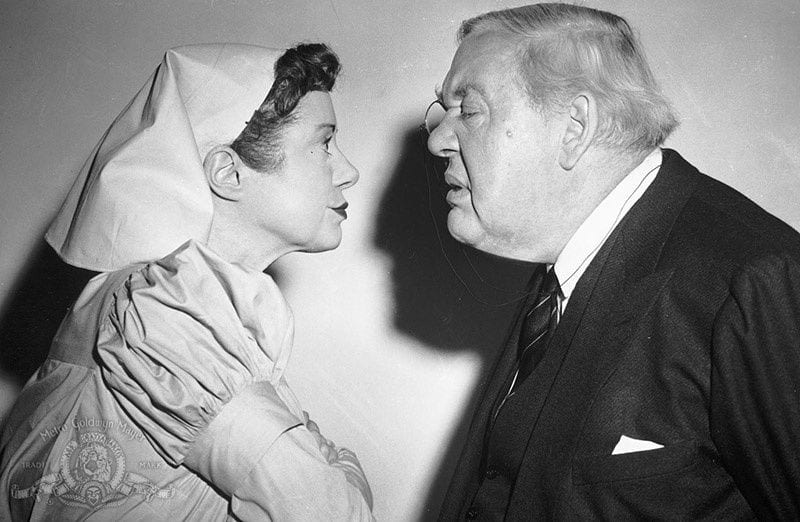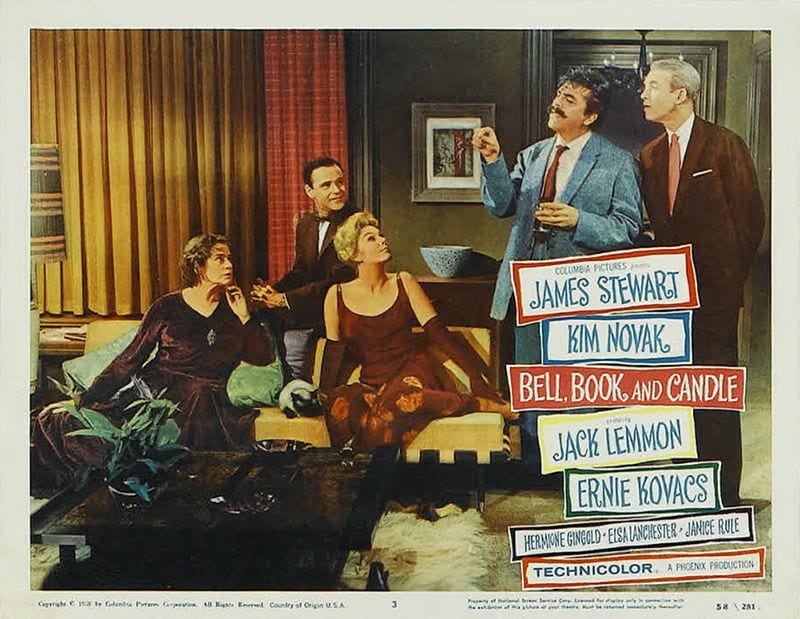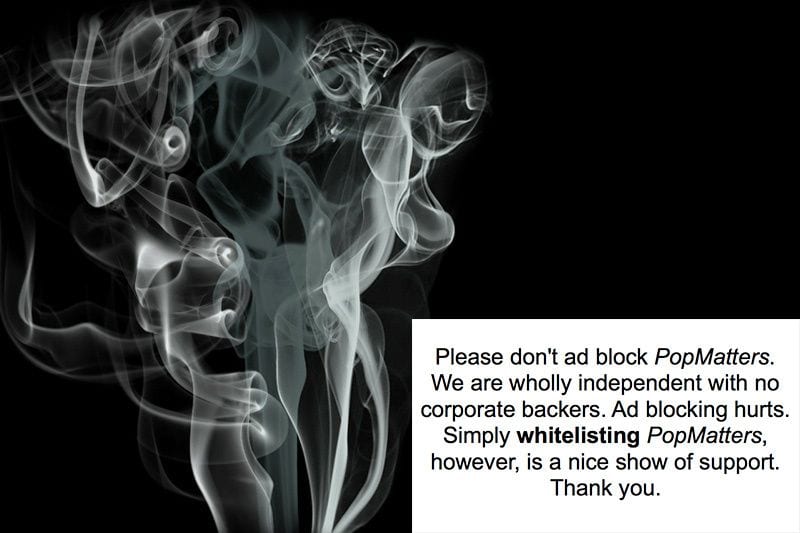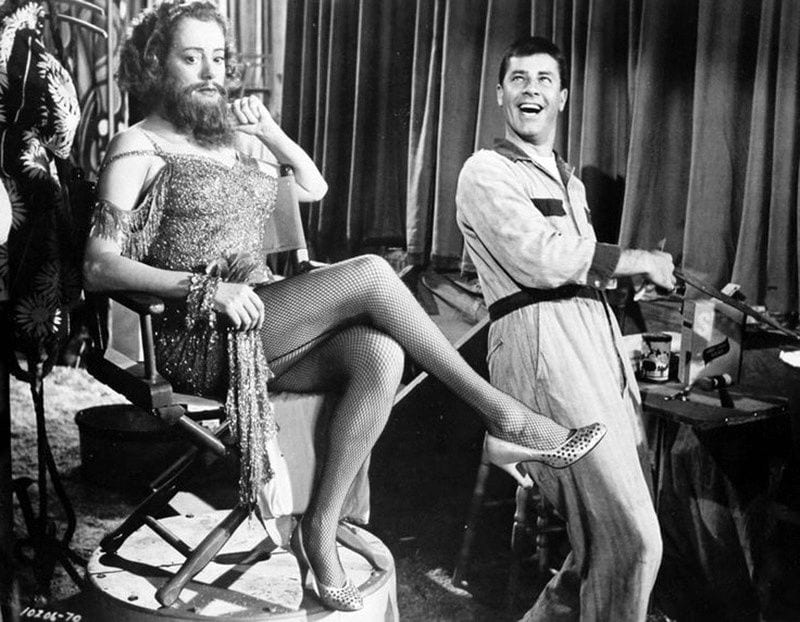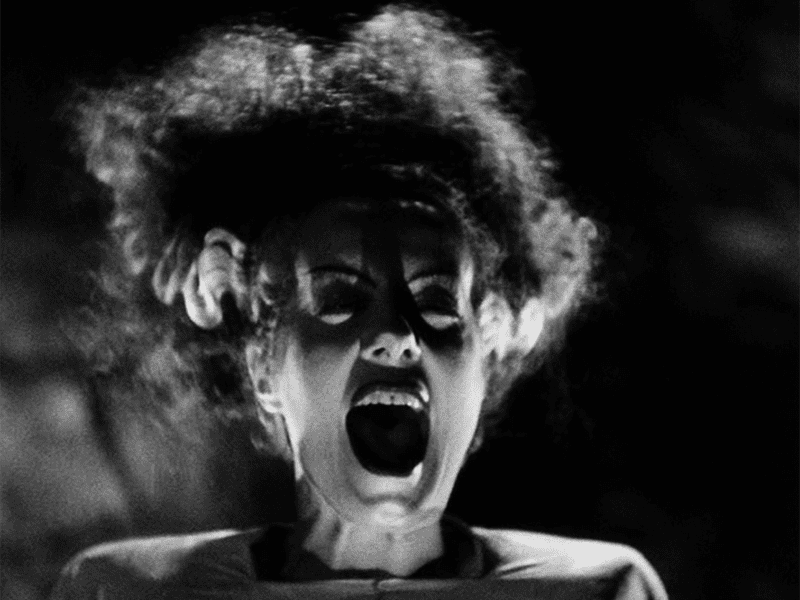
Oscar-nominated for Supporting Actress in Billy Wilder’s Witness for the Prosecution (1957), Elsa Lanchester might also be remembered as pranking witch Aunt Queenie in Bell, Book and Candle (1958), Katie Nanna in the opening scene of Mary Poppins (1964), sleuth Jessica Marbles in the cult comedy Murder by Death (1976), and a nagging mother in the rat-infested horror classic Willard (1971). Above all, Lanchester is known for playing The Bride in James Whales’ The Bride of Frankenstein (1935). Though onscreen no more than ten minutes, the iconic monster bride—modeled after Nefertiti, hissing like a defensive swan—followed Lanchester throughout her life as an actor, a singer, and one of the 20th century’s best kept secrets.
Lanchester struggled for visibility not only in the shadow of The Bride of Frankenstein but also her own husband, the Oscar-winning actor Charles Laughton, who brought larger than life characters to the screen like Henry VIII, the hunchback of Notre Dame, and Mutiny on the Bounty‘s Captain Bligh. A temperamental, outsized genius and admitted homosexual, Laughton dominates Lanchester’s autobiography. I say “dominates”, but Lanchester’s perceptive powers, her simultaneous precision and generosity, dominate the storytelling itself, providing narrative balance; Lanchester is telling her own story as a stalwart individual throughout it all. Anyone interested in classic Hollywood and what we might call pre-queer queerness should read Lanchester’s autobiography Elsa Lanchester: Herself, first published by St. Martin’s Press in 1983, when Lanchester was 80-years-old, and recently reprinted as a handsome paperback by Chicago Review Press.
The prologue alone lays out how Lanchester was pretty much born to defy heteronormativity. Her parents, Edith (“Biddy”) and James (“Shamus”), nonconformist activists loyal to socialism, unionism, suffragism, and vegetarianism, went so far as to reject the convention of marriage itself. In England, 1895, this proved a controversy so ground-shaking for Edith’s prosperous family that her father and brothers kidnapped her and committed her to an insane asylum, the cause of her insanity certified as “over-education”. Though Edith’s insanity status was soon overturned, the case—in headlines worldwide referred to as The Lanchester Kidnapping Case—forever framed lifelong partners Edith and James and their two children. Iron-willed “Biddy” is the one other person to matter most in Lanchester’s life and autobiography. She writes that her mother would “justify her own battle with her family through me, by having a bright child to prove her early actions were right. She’d show them—and in a way I wanted to show them too.”
Growing up notorious suited Lanchester, she claims: “I found it rather glamorous to be a bastard.” Political rallies are common among her childhood memories, plus “male impersonators” at the music hall and her brother’s all-boys school at which she was the only female student. Family life involved equal parts adventure and eviction. Mother took on landlords with every loophole in dozens of bylaws, finding it “irresistible to get the better of the upper classes.” With deft immediacy and steady-toned wit, Lanchester illuminates characters and locales, lucidly recalling a social dimension of quirky extremes and steadfast convictions. Recalling her first dance class at age 11, its instructor none other than legendary Isadora Duncan, Lanchester writes how “all Isadora could do was teach us to run away from or toward an enemy or to become an autumn leaf.”
Absorbing her parents’ values if not their commitment to activism, Lanchester gravitated toward people who were bright and remarkable, often bohemian, often thespian, while avoiding as she could the dull and the orthodox. Thus, starting early on, she created what she calls “the crosscurrents of friendships” on which one builds a well-rounded life—not to mention a well-rounded, indeed fascinating life story. She may have married, contrary to her parents, but her marriage was even more unconventional. Yes, the marriage sheltered Laughton from public suspicion about his sexual orientation and yes, as she notes several times if vaguely, it allowed Lanchester herself a certain freedom. Nevertheless, as fellow actors, nature lovers, art collectors, intellectual eccentrics, traveling companions, and domestic intimates, their bond surpassed all others throughout their 35 years together.
Back in the mid-1930s, Lanchester and Laughton appealed to movie fans as married British actors working in Hollywood. Lanchester gained visibility, ironically perhaps, with her memoir, Charles Laughton and I (1938), originally an article series and then a book. The title reflected her eclipsed stardom, post-Bride of Frankenstein, as Laughton’s career took off, yet Hollywood was at a loss for what to do with his wife. Her 1983 autobiography, despite the title Elsa Lanchester: Herself, still manages to create a clearer picture of Laughton’s career than her own. For example, her most successful films at the box office, Bell, Book and Candle and Willard, go unacknowledged. Above all, Lanchester’s life as a critically acclaimed singer goes underreported.
As a longtime fan of Lanchester’s cult-worthy albums from the late ’50s (Songs for a Shuttered Parlour and Songs for a Smoke-Filled Room), I wanted to hear more about her 12 years developing that material at Hollywood’s beloved Turnabout Theater. Her songwriter, Forman Brown, was one of the three men who cofounded the theater, all three living together as what we’d now call a “throuple”. We don’t learn this much, or much about Brown at all, perhaps out of respect for his privacy, but he penned dozens of witty songs for Lanchester and the Turnabout troupe made for a highly original little family. She recalls that even her husband considered the Brown-Lanchester team “a true artistic marriage of talents—and a happy one”. Not dedicating more page-time to Turnabout is not a flaw, per se, though part of a pattern of authorial deference to Laughton and his career.
What makes Elsa Lanchester: Herself such a compelling read is not her career arc, anyway. Furthermore, hers is not the more familiar story of a heterosexual woman married to a homosexual man. Lanchester’s story makes no claim to sexual identity, barely traces three or four almost passions with male friends, adding up to possible asexuality. She writes of herself in her early 20s: “I despised women who had to have a sex life. I thought: ‘I’ll show them.’ There was no element of keeping pure for anyone—just for myself.” This lays a characterological groundwork for the later scene in which her husband comes out to her and her acceptance is almost instantaneous. The only thing she resents is that one of the sexual encounters he confesses to her occurred on their sofa, which she replaces.
Lanchester may focus on her husband as she does, the book reaching its narrative climax with his death from cancer in 1962, because she tells his story so well, and only she can lay bare his microcircuitry. Being true to each other, their marriage allowed them to be true to themselves. Lanchester is a free spirit in a dowdy frame, a beaming wit who’s never above peeling potatoes; as her mother once said, “Ideas fly from Elsa like sparks from an anvil.” Her autobiography takes a delightfully obscure angle on Hollywood celebrity and the institution of marriage, queering both in ways that readers might appreciate today more than when first released in 1983. Elsa Lanchester died in 1986 and her ashes were scattered over the Pacific Ocean.


